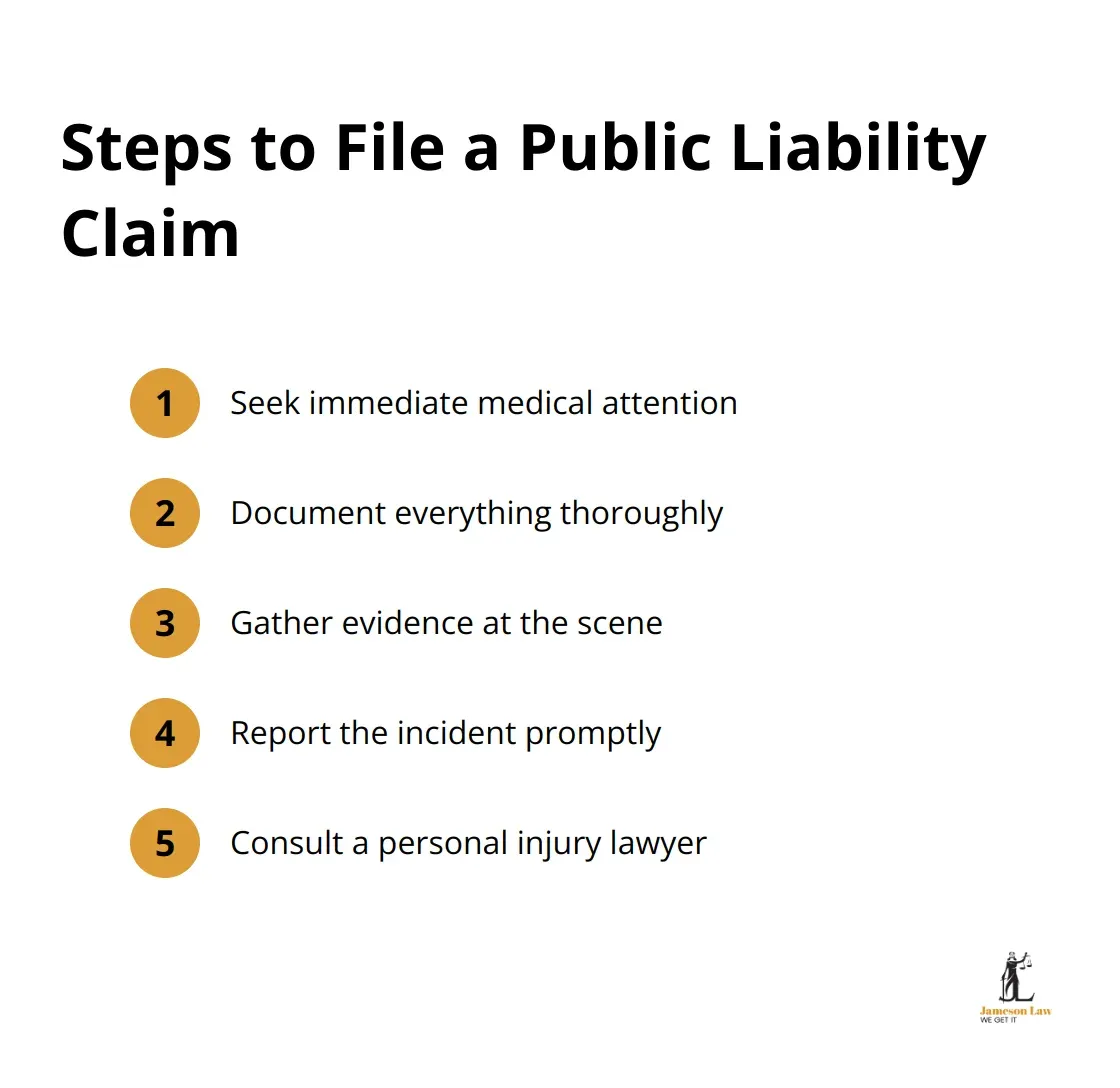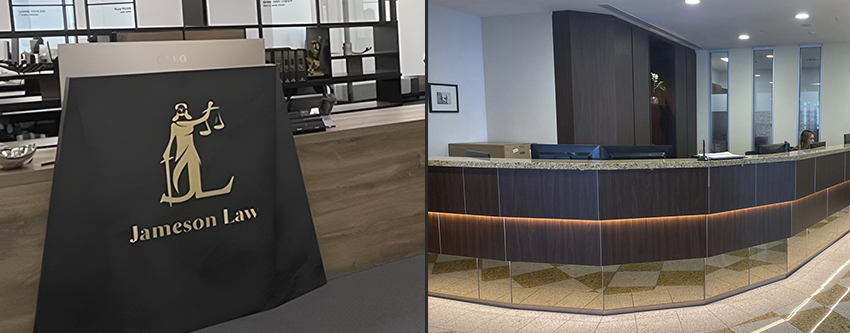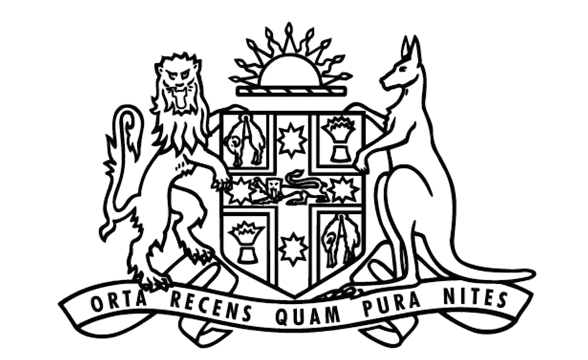Public liability injury claims can be complex and overwhelming for those unfamiliar with the legal process.
At Jameson Law, we understand the challenges faced by individuals seeking compensation for injuries sustained in public spaces.
This guide will walk you through the essential steps to file a public liability claim in Australia, ensuring you’re well-equipped to protect your rights and secure fair compensation.
Understanding Public Liability Claims in Australia
Definition and Scope
Public liability law in Australia applies when a person or entity is found liable for causing harm to another person or their property when a duty of care was owed. These claims form a critical part of Australia’s legal system, offering protection to those harmed by others’ negligence.
Common Types of Public Liability Injuries
Slips and falls top the list of public liability claims in Australia. These incidents often occur in supermarkets, shopping centres, or on poorly maintained footpaths. Other frequent injuries include:
![]() Impacts from falling objects in stores
Impacts from falling objects in stores
![]() Dog bites in public parks
Dog bites in public parks
![]() Accidents in playgrounds or recreational facilities
Accidents in playgrounds or recreational facilities
Legal Framework in Australia
The foundation of public liability claims in Australia rests on the duty of care principle. This principle is codified in state-specific legislation, such as the Civil Liability Act 2002 (NSW). These laws require property owners and occupiers to take reasonable steps to ensure visitor safety.
To succeed in a public liability claim, you must prove three key elements:

Time Limits and Evidence Collection
Swift action is essential if you believe you have a claim. While time limits vary, in most cases you have three years to file your claim, and strict notification rules apply for incidents in New South Wales.
Evidence collection plays a pivotal role in these cases. Key pieces of evidence include:
![]() Photographs of the accident scene
Photographs of the accident scene
![]() Witness statements
Witness statements
![]() Medical reports detailing your injuries
Medical reports detailing your injuries
Compensation and Potential Outcomes
Compensation in personal injury claims can cover various aspects:
![]() Medical expenses
Medical expenses
![]() Lost wages
Lost wages
![]() Pain and suffering
Pain and suffering
The settlement amount varies widely based on injury severity and life impact. Serious cases can result in settlements reaching hundreds of thousands of dollars.
It’s worth noting that not all claims end up in court. Many reach resolution through negotiation with insurance companies. Expert legal representation can significantly influence these negotiations’ outcomes.
How to File a Public Liability Claim
Filing a public liability claim in Australia requires swift action and meticulous attention to detail. This step-by-step guide will help you navigate the process effectively.

Seek Immediate Medical Attention
Your health takes priority. After an injury, visit a doctor or hospital without delay. This action serves two purposes:
![]() It ensures you receive proper care
It ensures you receive proper care
![]() It creates an official medical record
It creates an official medical record
Document Everything Thoroughly
Start a detailed injury diary. Record your symptoms, pain levels, and the injury’s impact on your daily life. Keep all receipts for medical expenses (including medications and travel costs for appointments). Take photos of your injuries as they heal and any visible damage to your belongings.
Gather Evidence at the Scene
If possible, return to the accident site and photograph the hazard that caused your injury. Look for surveillance cameras in the area; their footage could provide valuable evidence. Collect contact information from any witnesses, as their statements can significantly strengthen your case.
Report the Incident Promptly
Notify the property owner or manager about the incident as soon as possible. Many businesses have specific procedures for reporting accidents. Request a copy of the incident report for your records. Be factual in your account, but avoid admitting fault or downplaying your injuries.
Consult a Personal Injury Solicitor
While not mandatory, seeking legal advice from a personal injury solicitor can greatly improve your chances of a successful claim. They can help you understand your rights, assess the strength of your case, and guide you through the complex legal process. Many solicitors offer free initial consultations, allowing you to discuss your case without financial commitment.
Navigating the Claims Process: What to Expect
Time Limits for Filing Claims
Strict time limits apply to public liability claims in Australia, typically three years. In NSW, you must notify the defendant of your claim intention within six months of the incident or within six months of first noticing injury symptoms. Missing these deadlines can jeopardise your right to compensation.
Negotiating with Insurance Companies
After you file your claim, you’ll likely interact with the defendant’s insurer. Insurance adjusters aim to minimise payouts and may use various tactics to reduce or deny your claim’s value.
To protect your interests:
![]() Understand the basics of injury compensation
Understand the basics of injury compensation
![]() Document everything related to your injury
Document everything related to your injury
![]() Seek medical attention immediately
Seek medical attention immediately
![]() Consult with a personal injury solicitor
Consult with a personal injury solicitor
Settlement vs. Court Proceedings
Most Australian public liability claims resolve through out-of-court settlements. This approach often proves faster and less stressful than trials. However, if negotiations fail or the insurer refuses fair compensation, your case may proceed to court.
No Win No Fee Arrangements
Many Australian personal injury solicitors offer No Win No Fee arrangements for public liability cases. This means you don’t pay legal fees unless your claim succeeds. However, you must understand these agreement terms, as you may still bear other claim-related costs.
Expert Guidance
Navigating the claims process can challenge even the most prepared individuals. An experienced personal injury solicitor can:
![]() Explain your rights and obligations
Explain your rights and obligations
![]() Assess your claim’s strength
Assess your claim’s strength
![]() Handle complex legal procedures
Handle complex legal procedures
![]() Negotiate with insurance companies
Negotiate with insurance companies
![]() Represent you in court (if necessary)
Represent you in court (if necessary)
Final Thoughts
Public liability injury claims require swift action and meticulous documentation. You must seek immediate medical attention, gather comprehensive evidence, and report the incident promptly to strengthen your case. Time limits for filing claims are strict, and missing deadlines can jeopardise your right to compensation.
At Jameson Law, we specialise in public liability and personal injury claims, providing tailored legal support throughout the process. Our team’s experience and commitment to achieving the best outcomes for our clients ensure you receive fair compensation. Don’t navigate this complex journey alone – let Jameson Law’s expertise work for you in securing the compensation you deserve.













